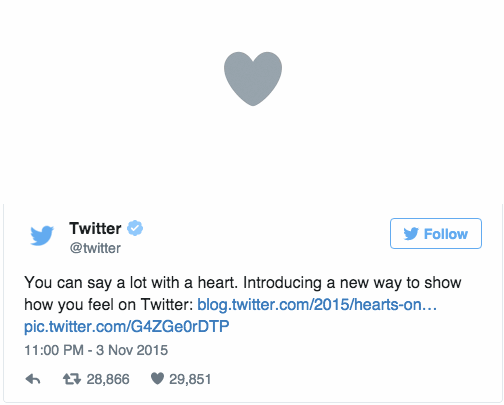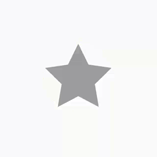Twitter的like动画安卓版 - 备选方案
英文原文:Twitter's like animation in Android - alternative
不久前Twitter展示了具有现代感的心形动画-作为star图标的替代。

虽然心形标志更普遍和昂贵,但是今天我们尝试复制新的动画,使用旧的星星图标。我们的效果如下(比gif图快一点点):

虽然实现这个动画最简单的方法是使用 Frame Animation,但是我们尝试用更灵活的方法来实现-手动绘制并用属性动画。这篇文章只是概要,没有深入的技术细节。
实现
我们将创建一个名叫LikeButtonView的view,它是一个由三个子view构成的FrameLayout- CircleView 显示星星图标下面的圆,ImageView (星星)以及代表按钮周围浮点的DotsView 。
CircleView

这个视图负责绘制星星图标下面的大圆。它本可以实现得更简单(通过xml),但是这里我们应该考虑按钮下面的背景颜色。
我们在canvas上绘制圆的实现:
Override
protected void onDraw(Canvas canvas) {
super.onDraw(canvas);
tempCanvas.drawColor(0xffffff, PorterDuff.Mode.CLEAR);
tempCanvas.drawCircle(getWidth() / 2, getHeight() / 2, outerCircleRadiusProgress * maxCircleSize, circlePaint);
tempCanvas.drawCircle(getWidth() / 2, getHeight() / 2, innerCircleRadiusProgress * maxCircleSize, maskPaint);
canvas.drawBitmap(tempBitmap, 0, 0, null);
}
ondraw.java hosted with ❤ by GitHub
先使用CLEAR 模式绘制颜色以清除canvas。然后根据给定的进度(各自的进度是独立的)绘制内外圆。
内圆使用这样定义的mask paint :
maskPaint.setXfermode(new PorterDuffXfermode(PorterDuff.Mode.CLEAR));
maskPaint.java hosted with ❤ by GitHub
意味着内圆将在外圆内部创建一个透明的洞。
我们视图中使用了tempBitmap的tempCanvas定义如下:
Override
protected void onSizeChanged(int w, int h, int oldw, int oldh) {
super.onSizeChanged(w, h, oldw, oldh);
maxCircleSize = w / 2;
tempBitmap = Bitmap.createBitmap(getWidth(), getWidth(), Bitmap.Config.ARGB_8888);
tempCanvas = new Canvas(tempBitmap);
}
onSizeChanged.java hosted with ❤ by GitHub
我们需要完全透明,不然的话内圆就会显示窗口颜色。
对于那些眼睛机灵的人应该还注意到了另外一件事-我们的外圆颜色是基于当前进度而变化的。这是通过ArgbEvaluator 类来完成,该类可以基于一个给定的因子在两个颜色之间变换:
private void updateCircleColor() {
float colorProgress = (float) Utils.clamp(outerCircleRadiusProgress, 0.5, 1);
colorProgress = (float) Utils.mapValueFromRangeToRange(colorProgress, 0.5f, 1f, 0f, 1f);
this.circlePaint.setColor((Integer) argbEvaluator.evaluate(colorProgress, START_COLOR, END_COLOR));
}
updateCircleColor.java hosted with ❤ by GitHub
CircleView代码的剩余部分就是一个实现的问题了。完整的源代码可以在这里找到: CircleView。
DotsView

这个view将绘制浮动在星星图标周围的圆点。跟CircleView一样,它是使用onDraw()来做这件事的:
@Override
protected void onDraw(Canvas canvas) {
drawOuterDotsFrame(canvas);
drawInnerDotsFrame(canvas);
}
private void drawOuterDotsFrame(Canvas canvas) {
for (int i = 0; i < DOTS_COUNT; i++) {
int cX = (int) (centerX + currentRadius1 * Math.cos(i * OUTER_DOTS_POSITION_ANGLE * Math.PI / 180));
int cY = (int) (centerY + currentRadius1 * Math.sin(i * OUTER_DOTS_POSITION_ANGLE * Math.PI / 180));
canvas.drawCircle(cX, cY, currentDotSize1, circlePaints\[i % circlePaints.length\]);
}
}
private void drawInnerDotsFrame(Canvas canvas) {
for (int i = 0; i < DOTS_COUNT; i++) {
int cX = (int) (centerX + currentRadius2 * Math.cos((i * OUTER_DOTS_POSITION_ANGLE - 10) * Math.PI / 180));
int cY = (int) (centerY + currentRadius2 * Math.sin((i * OUTER_DOTS_POSITION_ANGLE - 10) * Math.PI / 180));
canvas.drawCircle(cX, cY, currentDotSize2, circlePaints\[(i + 1) % circlePaints.length\]);
}
}
onDraw2.java hosted with ❤ by GitHub
圆点是基于currentProgress绘制的,背后是数学逻辑,老实说从安卓sdk的角度来看这里没有什么有趣的地方,倒是有两个跟数学相关的东西:
-
圆点分布在一个圆上-它们的位置决定于:
int cX = (int) (centerX + currentRadius1 * Math.cos(i * OUTER_DOTS_POSITION_ANGLE * Math.PI / 180));
int cY = (int) (centerY + currentRadius1 * Math.sin(i * OUTER_DOTS_POSITION_ANGLE * Math.PI / 180));
意味着:在每个OUTER_DOTS_POSITION_ANGLE上设置圆点 (51 度).
-
每个圆点都有它自己的颜色动画:
private void updateDotsPaints() { if (currentProgress < 0.5f) { float progress = (float) Utils.mapValueFromRangeToRange(currentProgress, 0f, 0.5f, 0, 1f); circlePaints\[0\].setColor((Integer) argbEvaluator.evaluate(progress, COLOR_1, COLOR_2)); circlePaints\[1\].setColor((Integer) argbEvaluator.evaluate(progress, COLOR_2, COLOR_3)); circlePaints\[2\].setColor((Integer) argbEvaluator.evaluate(progress, COLOR_3, COLOR_4)); circlePaints\[3\].setColor((Integer) argbEvaluator.evaluate(progress, COLOR_4, COLOR_1)); } else { float progress = (float) Utils.mapValueFromRangeToRange(currentProgress, 0.5f, 1f, 0, 1f); circlePaints\[0\].setColor((Integer) argbEvaluator.evaluate(progress, COLOR_2, COLOR_3)); circlePaints\[1\].setColor((Integer) argbEvaluator.evaluate(progress, COLOR_3, COLOR_4)); circlePaints\[2\].setColor((Integer) argbEvaluator.evaluate(progress, COLOR_4, COLOR_1)); circlePaints\[3\].setColor((Integer) argbEvaluator.evaluate(progress, COLOR_1, COLOR_2)); } }这意味着圆点颜色在3个区间形式的值之间动画。我们再一次使用ArgbEvaluator 让它平滑。其余就很简单了。这个类的完整代码在这里:DotsView
LikeButtonView
最终的ViewGroup是由CircleView, ImageView 以及DotsView组成的。
<?xml version="1.0" encoding="utf-8"?>
<merge xmlns:android="http://schemas.android.com/apk/res/android"
android:layout_width="match_parent"
android:layout_height="match_parent">
<frogermcs.io.likeanimation.DotsView
android:id="@+id/vDotsView"
android:layout_width="200dp"
android:layout_height="200dp"
android:layout_gravity="center"/>
<frogermcs.io.likeanimation.CircleView
android:id="@+id/vCircle"
android:layout_width="80dp"
android:layout_height="80dp"
android:layout_gravity="center"/>
<ImageView
android:id="@+id/ivStar"
android:layout_width="wrap_content"
android:layout_height="wrap_content"
android:layout_gravity="center"
android:src="@drawable/ic_star_rate_off"/>
</merge>
likebutton.xml hosted with ❤ by GitHub
我们使用 Merge 标签帮助消除多余的ViewGroup。LikeButtonView本身就是一个FrameLayout,因此没有必要出现两次。
我们最终的动画是由更小的动画组成的,通过AnimatorSet一起播放:
@Override
public void onClick(View v) {
//...
animatorSet = new AnimatorSet();
ObjectAnimator outerCircleAnimator = ObjectAnimator.ofFloat(vCircle, CircleView.OUTER_CIRCLE_RADIUS_PROGRESS, 0.1f, 1f);
outerCircleAnimator.setDuration(250);
outerCircleAnimator.setInterpolator(DECCELERATE_INTERPOLATOR);
ObjectAnimator innerCircleAnimator = ObjectAnimator.ofFloat(vCircle, CircleView.INNER_CIRCLE_RADIUS_PROGRESS, 0.1f, 1f);
innerCircleAnimator.setDuration(200);
innerCircleAnimator.setStartDelay(200);
innerCircleAnimator.setInterpolator(DECCELERATE_INTERPOLATOR);
ObjectAnimator starScaleYAnimator = ObjectAnimator.ofFloat(ivStar, ImageView.SCALE_Y, 0.2f, 1f);
starScaleYAnimator.setDuration(350);
starScaleYAnimator.setStartDelay(250);
starScaleYAnimator.setInterpolator(OVERSHOOT_INTERPOLATOR);
ObjectAnimator starScaleXAnimator = ObjectAnimator.ofFloat(ivStar, ImageView.SCALE_X, 0.2f, 1f);
starScaleXAnimator.setDuration(350);
starScaleXAnimator.setStartDelay(250);
starScaleXAnimator.setInterpolator(OVERSHOOT_INTERPOLATOR);
ObjectAnimator dotsAnimator = ObjectAnimator.ofFloat(vDotsView, DotsView.DOTS_PROGRESS, 0, 1f);
dotsAnimator.setDuration(900);
dotsAnimator.setStartDelay(50);
dotsAnimator.setInterpolator(ACCELERATE_DECELERATE_INTERPOLATOR);
animatorSet.playTogether(
outerCircleAnimator,
innerCircleAnimator,
starScaleYAnimator,
starScaleXAnimator,
dotsAnimator
);
//...
animatorSet.start();
}
全是关于恰当的时间和插值器。

我们的LikeButtonView还会响应触摸事件(缩放动画):
@Override
public boolean onTouchEvent(MotionEvent event) {
switch (event.getAction()) {
case MotionEvent.ACTION_DOWN:
ivStar.animate().scaleX(0.7f).scaleY(0.7f).setDuration(150).setInterpolator(DECCELERATE_INTERPOLATOR);
setPressed(true);
break;
case MotionEvent.ACTION_MOVE:
float x = event.getX();
float y = event.getY();
boolean isInside = (x > 0 && x < getWidth() && y > 0 && y < getHeight());
if (isPressed() != isInside) {
setPressed(isInside);
}
break;
case MotionEvent.ACTION_UP:
ivStar.animate().scaleX(1).scaleY(1).setInterpolator(DECCELERATE_INTERPOLATOR);
if (isPressed()) {
performClick();
setPressed(false);
}
break;
}
return true;
}
以上就是全部。就如你看到的,这里没有神秘的东西,但是最终的效果却很赞。那么现在该干什么呢?让我们用它来美化自己的app吧。
源码
所描述的项目的完整源代码可以在github的repository上获取。
作者
写于2015年12月22号
打赏(译者)






